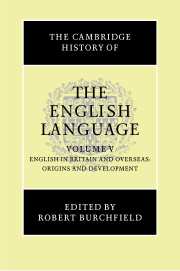Book contents
- Frontmatter
- 1 Introduction
- PART I Regional varieties of English in Great Britain and Ireland
- PART II English overseas
- 6 ENGLISH IN AUSTRALIA
- 7 ENGLISH IN THE CARIBBEAN
- 8 ENGLISH IN NEW ZEALAND
- 9 ENGLISH IN SOUTH AFRICA
- 10 ENGLISH IN SOUTH ASIA
- Glossary of linguistic terms
- Bibliography
- Index
- THE CAMBRIDGE HISTORY OF THE ENGLISH LANGUAGE
- Map 7.1 Movements of English/Creole speakers in the seventeenth century
- Map 7.2 Movements of English/Creole speakers after 1700
- References
10 - ENGLISH IN SOUTH ASIA
from PART II - English overseas
Published online by Cambridge University Press: 28 March 2008
- Frontmatter
- 1 Introduction
- PART I Regional varieties of English in Great Britain and Ireland
- PART II English overseas
- 6 ENGLISH IN AUSTRALIA
- 7 ENGLISH IN THE CARIBBEAN
- 8 ENGLISH IN NEW ZEALAND
- 9 ENGLISH IN SOUTH AFRICA
- 10 ENGLISH IN SOUTH ASIA
- Glossary of linguistic terms
- Bibliography
- Index
- THE CAMBRIDGE HISTORY OF THE ENGLISH LANGUAGE
- Map 7.1 Movements of English/Creole speakers in the seventeenth century
- Map 7.2 Movements of English/Creole speakers after 1700
- References
Summary
Introduction
The history of English in South Asia is one of prolonged heated debates and controversies. The controversy about the legacy of English and desirability of its continued place in language policies and its cultural associations has still not abated. However, the political map of South Asia is completely altered now from the way it was when the English language was originally introduced to the subcontinent over two centuries ago. The profile of English in the subcontinent is also different from that in 1947 when the colonial period came to an end and the country was divided into India and Pakistan. One task of the two new governments was to determine the role of almost 560 sovereign states which were ruled by maharajas, nawabs and lesser luminaries depending on the status and revenue of each state. In 1972, an independent nation, Bangladesh, was carved out of Pakistan after considerable bloodshed. When we refer to contemporary South Asia, we are talking of the following seven sovereign states: India (pop. 1,042·5 million), Pakistan (pop. 162·46 million), Bangladesh (pop. 150·6 million), Sri Lanka (pop. 19·39 million), Nepal (pop. 24·0 million), Bhutan (1·9 million) and Maldives (pop. 0·272 million).
The projected population of this region in the year 2000 is 1,401 million, which will be 22·4 per cent of the world's population. The largest percentage (74·4) of this population will be in India, and the smallest percentage (0·19) in Maldives. These political divisions, though meaningful at one level, are somewhat misleading at another level.
Keywords
- Type
- Chapter
- Information
- The Cambridge History of the English Language , pp. 497 - 553Publisher: Cambridge University PressPrint publication year: 1994
References
- 42
- Cited by



